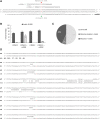CRISPR-AsCas12a Efficiently Corrects a GPR143 Intronic Mutation in Induced Pluripotent Stem Cells from an Ocular Albinism Patient
- PMID: 35686978
- PMCID: PMC9233509
- DOI: 10.1089/crispr.2021.0110
CRISPR-AsCas12a Efficiently Corrects a GPR143 Intronic Mutation in Induced Pluripotent Stem Cells from an Ocular Albinism Patient
Abstract
Mutations in the GPR143 gene cause X-linked ocular albinism type 1 (OA1), a disease that severely impairs vision. We recently generated induced pluripotent stem cells (iPSCs) from skin fibroblasts of an OA1 patient carrying a point mutation in intron 7 of GPR143. This mutation activates a new splice site causing the incorporation of a pseudoexon. In this study, we present a high-performance CRISPR-Cas ribonucleoprotein strategy to permanently correct the GPR143 mutation in these patient-derived iPSCs. Interestingly, the two single-guide RNAs available for SpCas9 did not allow the cleavage of the target region. In contrast, the cleavage achieved with the CRISPR-AsCas12a system promoted homology-directed repair at a high rate. The CRISPR-AsCas12a-mediated correction did not alter iPSC pluripotency or genetic stability, nor did it result in off-target events. Moreover, we highlight that the disruption of the pathological splice site caused by CRISPR-AsCas12a-mediated insertions/deletions also rescued the normal splicing of GPR143 and its expression level.
Conflict of interest statement
No competing financial interests exist.
Figures





Similar articles
-
Generation of a human Ocular Albinism type 1 iPSC line, SEIi001-A, with a mutation in GPR143.Stem Cell Res. 2018 Dec;33:274-277. doi: 10.1016/j.scr.2018.11.016. Epub 2018 Nov 28. Stem Cell Res. 2018. PMID: 30513407
-
A novel GPR143 mutation in a Chinese family with X‑linked ocular albinism type 1.Mol Med Rep. 2020 Jan;21(1):240-248. doi: 10.3892/mmr.2019.10813. Epub 2019 Nov 12. Mol Med Rep. 2020. PMID: 31746431 Free PMC article. Clinical Trial.
-
Aberrant splicing in the ocular albinism type 1 gene (OA1/GPR143) is corrected in vitro by morpholino antisense oligonucleotides.Hum Mutat. 2006 May;27(5):420-6. doi: 10.1002/humu.20303. Hum Mutat. 2006. PMID: 16550551
-
Pigmentation and vision: Is GPR143 in control?J Neurosci Res. 2019 Jan;97(1):77-87. doi: 10.1002/jnr.24246. Epub 2018 May 14. J Neurosci Res. 2019. PMID: 29761529 Free PMC article. Review.
-
Ocular albinism type 1: more than meets the eye.Pigment Cell Res. 2001 Aug;14(4):243-8. doi: 10.1034/j.1600-0749.2001.140403.x. Pigment Cell Res. 2001. PMID: 11549106 Review.
Cited by
-
Highly parallel profiling of the activities and specificities of Cas12a variants in human cells.Nat Commun. 2025 Mar 28;16(1):3022. doi: 10.1038/s41467-025-57150-9. Nat Commun. 2025. PMID: 40155371 Free PMC article.
-
The molecular landscape of oculocutaneous albinism in India and its therapeutic implications.Eur J Hum Genet. 2024 Oct;32(10):1267-1277. doi: 10.1038/s41431-023-01496-5. Epub 2023 Nov 30. Eur J Hum Genet. 2024. PMID: 38030918
References
Publication types
MeSH terms
Substances
Supplementary concepts
LinkOut - more resources
Full Text Sources
Research Materials
